77.1 Using GroupWise AutoUpdate and SetupIP to Distribute the GroupWise Windows Client
The GroupWise Windows client Setup program (setup.exe) includes an AutoUpdate feature that helps you keep users’ Windows client software up to date. Each time the GroupWise Windows client starts, it checks with the POA for the user’s post office to find out if new Windows client software is available in the post office’s software distribution directory. When new software is available and AutoUpdate is enabled, the Setup program can prompt the user to install the updated software.
By default, AutoUpdate checks for a mapped drive to a software distribution directory from which to install the client software. This requires that users have rights to directly access the software distribution directory. To eliminate the need to give users rights to the software distribution directory, you can configure the SetupIP feature to download the client software from a Web server, so that the client installation can run locally on users’ workstations.
After AutoUpdate locates the software, either across a mapped drive or by downloading it from a Web server, the installation of the client software by the client Setup program is controlled by the setup configuration file (setup.cfg).
77.1.1 Preparing for AutoUpdate
Preparing Your Software Distribution Directory to Support AutoUpdate
During the installation of GroupWise Administration, you had the opportunity to plan and set up a software distribution directory, as described in GroupWise Software Distribution Directory
in Installing a Basic GroupWise System
in the GroupWise 2012 Installation Guide.
On Windows, if you selected when you initially created your software distribution directory, the GroupWise Windows client software was copied from the downloaded GroupWise 2012 software image into the client subdirectory of the software distribution directory.
On Linux, the GroupWise Windows client software is always copied into the software distribution directory, because the Linux GroupWise Installation program does not include an option for selecting .
The default location of the software distribution directory varies by platform:
|
Linux: |
|
|
Windows: |
If the software distribution directory already contains the Windows client software, follow the instructions for the type of client installation you want to perform:
If you have not yet copied the Windows client software to the software distribution directory:
-
Start the Windows GroupWise Installation program.
-
Click , click to accept the License Agreement, then click to accept a standard installation.
-
Select and deselect , so that only is selected, then click .
-
Deselect , so that only is selected, then click .
-
Specify or browse to and select your software distribution directory, then click .
-
Select , then click .
-
Review your selections, then click .
-
When the Windows client software files have been copied to the software distribution directory, click .
-
If you want to distribute the Windows client software from a mapped network drive, continue with Preparing for Windows Client Installation from a Mapped Drive.
or
If you want to distribute the Windows client software from a Web server, so that the Windows client users do not need access rights to the software distribution directory, skip to Preparing for Windows Client Installation from a Web Server.
Preparing for Windows Client Installation from a Mapped Drive
-
Make sure that Windows client users have a drive mapped to the software distribution directory.
If the software distribution directory is on Linux and you need assistance with this task, you can follow the same basic procedure described in
Installing the GroupWise Windows Client from the Linux GroupWise 2012 Software Image
inInstallation
in the GroupWise 2012 Installation Guide to set up the connection. -
(Conditional) If the software distribution directory is on Linux, modify the configuration of the software distribution directory to make it available from the point of view of users’ Windows workstations:
-
In Windows ConsoleOne, click .
-
Select the software distribution directory on the Linux server where the Windows client software is located, then click .
-
In the field, change the Linux path provided by the Linux GroupWise Installation program or Linux ConsoleOne to the UNC path required to access the location from the point of view of Windows, then click .
IMPORTANT:Do not edit this software distribution directory in Linux ConsoleOne in the future. Doing so would change the location back to a Linux path and cause the AutoUpdate process to fail.
-
Click to close the Software Distribution Directory Management dialog box.
-
-
Make sure that users have Read and Scan rights to the following locations in the software distribution directory:
Preparing for Windows Client Installation from a Web Server
When the Windows client software was copied to the software distribution directory, the files required for installing the Windows client from a Web server were copied to:
software_distribution_directory/admin/utility/setupip
This applies to software distribution directories on Linux and on Windows. SetupIP can be configured to install the Windows client software from the Apache Web server on Linux or from the Internet Information Service (IIS) Web server on Windows.
-
Create a directory in the document root directory of your Web server for the GroupWise client software files used by SetupIP, for example:
Apache on Linux:
/srv/www/htdocs/gwclient
IIS on Windows:
c:\InetPub\wwwroot\gwclient
-
Create a win32 subdirectory under the client software directory that you created in Step 1.
After you customize the setup configuration file (setup.cfg), as described in Customizing the Setup Configuration File, you will copy it to the win32 subdirectory.
-
Browse to the following subdirectory in your software distribution directory:
software_distribution_directory/admin/utility/setupip -
Copy the setupip.fil file and any language-specific setupip.language_code files for languages you want to install, from the utility/setupip directory to the client software directory that you created in Step 1.
All language-independent Windows client software files are included in the setupip.fil file. The setupip.language_code file for each client language (setupip.en, setupip.de, setupip.fr, and so on) contains all client software files for the specific language indicated by the language code. If you copy multiple setupip.language_code files to the Web server, users are prompted for which languages they want to install.
-
On Windows, in the utility/setupip directory, run the WriteIP program (writeip.exe).
If the WriteIP program is located on a Linux server, you can use the same procedure for creating a connection from Windows to Linux when setting up SetupIP as you use when setting up ConsoleOne for use from Windows to Linux. For assistance, see Section 2.3, ConsoleOne in a Multiple-Platform Environment.
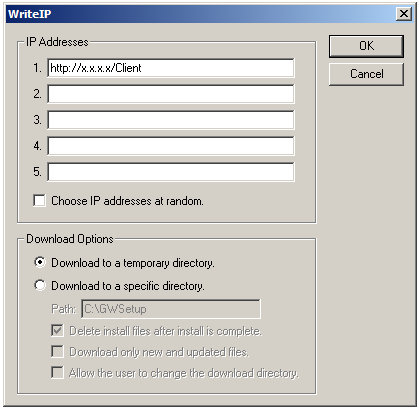
The WriteIP program (writeip.exe) creates a customized SetupIP program (setupip.exe) designed to work with the local Web server.
-
Specify the IP address location for the local setupip.fil file.
For example, you can specify:
http://172.16.5.18/gwclient
or
http://intranet.yourcompanyname.com/gwclient
You can include proxy and port information, for example:
http://name.yourcompanyname.com/gwclient;proxy.place.mycompany:1690
You can specify as many as five locations where you have made the GroupWise client software available on Web servers. During AutoUpdate, each location is checked, in order, until a connection is made.
-
(Optional) If you specify multiple locations, select so that the order in which the locations are checked is selected randomly when AutoUpdate occurs.
This balances the load on the Web servers.
-
(Optional) Select download options:
Download to a Temporary Directory: Select this option to download the Windows client software into a temporary directory that is automatically deleted after the user installs the updated client software.
Download to a Specific Directory: Select this option to control where and how the Windows client software is downloaded.
-
Path: Specify the directory where you want SetupIP to download the Windows client software.
-
Delete Install Files after Install Is Complete: Select this option to clean up the user’s workstation after the Windows client software is installed.
-
Download Only New and Updated Files: Select this option to shorten download time by downloading only new and modified software files.
-
Allow the User to Change the Download Directory: Select this option to prompt the user for the location to download the software files.
-
-
Click to create a customized setupip.exe file based on the settings you selected, then click again to exit the WriteIP program.
The writeip.ini file is also created, which stores the options you selected when running the WriteIP program.
-
Copy the custom setupip.exe file from the utility/setupip directory to the software_distribution_directory/client/win32 directory, so that it is in the same directory with the Windows client Setup program (setup.exe).
-
Configure your Web server to support SetupIP:
Apache on Linux
-
Open the Apache configuration file (/etc/apache2/httpd.conf) in a text editor.
-
Search for the following section:
<Directory />
-
After the default Directory section, add the following section for the GroupWise client software:
<Directory /srv/www/htdocs/gwclient> Options Indexes </Directory> -
On the Directory line, specify the client software directory that you created in Step 1 in Preparing for Windows Client Installation from a Web Server.
-
Save the file.
-
Restart Apache:
rcapache2 restart
-
Test the availability of the client software on the Web server by displaying the following URL and verifying the contents of the win32 directory:
http://web_server_address/gwclient
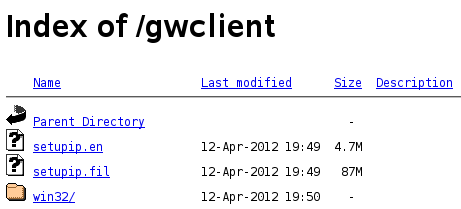
IIS on Windows Server 2008
-
On Windows Server 2008, click .
-
Expand the Local Computer object, expand the Sites folder, expand your Web site, then select the client software directory that you created in Step 1 in Preparing for Windows Client Installation from a Web Server.
-
Enable directory browsing so that the gwclient directory can be accessed:
-
In the Features View, double-click .
-
In the pane, click .
-
Click the client software directory to return to the Features View.
-
-
Configure IIS to allow the download of the client software files:
-
In the Features View, double-click .
-
In the pane, click .
-
In the field, type .* (a period followed by an asterisk).
-
In the field, type application/octet-stream.
-
Click .
-
Click the client software directory to return to the Features View.
-
-
(Conditional) If you have configured file filtering at a higher level in this Web site, configure IIS to not filter out files in the client software directory:
-
In the Features View, double-click .
-
Click .
-
In the field, type .* (a period followed by an asterisk).
-
Click .
-
-
Close IIS Manager.
-
Restart IIS:
-
Click .
-
Right-click , then click .
-
-
Test the availability of the client software on the Web server by displaying the following URL and verifying the contents of the win32 directory:
http://web_server_address/gwclient

IIS on Windows Server 2003
-
On Windows Server 2003, click .
-
Expand the Local Computer object, then expand the Web Sites folder.
-
Right-click your Web site, then click .
-
On the tab, select , then click .
-
Restart IIS:
-
Click .
-
Right-click , then click .
-
-
Test the availability of the client software on the Web server by displaying the following URL:
http://web_server_address/gwclient

-
Continue with Working with the Setup Configuration File.
77.1.2 Working with the Setup Configuration File
The AutoUpdate process is controlled by the setup configuration file (setup.cfg).
Understanding the Setup Configuration File
A default setup configuration file (setup.cfg) is provided in the following directory:
software_distribution_directory\client
The setup configuration file is an ASCII text file that supports extended ASCII characters. The file contains the responses normally provided by the user during the installation of the Windows client software. For example, the path for the Windows client software and the folder for the GroupWise desktop icon are specified in this file. In addition, information can be added to the setup configuration file to add predefined LDAP directory service accounts to the GroupWise Address Book in the Windows client during installation.
When the GroupWise Windows client Setup program (setup.exe) is executed, it looks in the same directory for a setup.cfg file. If none is found, the installation proceeds, prompting the user for the needed information. If the setup.cfg file is found, the Windows client Setup program proceeds, using the information specified in the setup configuration file. Depending on the entries in the setup configuration file, the user might or might not be prompted to provide information during the installation.
The setup configuration file is divided into the following sections. In the setup configuration file, each section head must be enclosed in brackets [ ] as shown.
[GroupWiseSetup]
Version= |
This entry must match the version being installed; otherwise, the Setup program does not use setup.cfg. The default is 8.0. |
Path= |
This entry specifies the path where you want the GroupWise Windows client to be installed. The default path for GroupWise 2012 is c:\Program Files\Novell\Groupwise. Earlier versions of GroupWise defaulted to c:\novell\groupwise. |
Folder= |
This entry creates and installs the GroupWise Windows client shortcuts to the specified folder in the user’s menu. The default folder is Novell GroupWise. |
LaunchMessenger= |
This optional entry specifies whether Novell Messenger should be launched when GroupWise starts. The default is No. |
LaunchNotify= |
This optional entry specifies whether GroupWise Notify should be launched when GroupWise starts. The default is No. |
GWMailTo= |
This entry specifies whether the GroupWise Windows client should be the default email application in your Web browser. The default is Yes, so that the Internet Browser Mail Integration is installed along with the GroupWise client. |
IPAddress= |
This optional entry specifies the IP address for the Windows client to always use. Use this setting to set the IP address per post office when using multiple post offices. |
IPPort= |
This optional entry specifies the IP port for the Windows client to always use. |
DefaultIPAddress= |
This optional entry specifies the default IP address for the Windows client to use the first time it is started. This should be an IP address that everyone on the system has access to. |
DefaultIPPort= |
This optional entry specifies the default IP port for the Windows client to use the first time it is started. |
StopService= |
Use this entry when you are running integrated third-party software along with the GroupWise Windows client, and that software might be locking some GroupWise Windows client DLLs. If client DLLs are locked, the client software cannot be installed. Specify the service for the client Setup program to stop before it installs the client software. Use the name as it appears in the list provided by . You can stop only one service before installing the client software. |
[ShowSetup]
ShowDialogs= |
Specify No to hide dialog boxes during the installation. Specify Yes to show the dialog boxes. The default is Yes. If an entry is missing from the setup.cfg file and ShowDialogs=Yes, the Setup program selects the default setting. If ShowDialogs=No, the Setup program prompts the user for a selection. NOTE:This option does not suppress the language selection dialog box that appears when you install the GroupWise Windows client from the multilanguage software image. For more information, see the GroupWise 2012 Readme. |
ShowProgress= |
Specify Yes to show the progress indicator during the installation. Specify No to hide the progress indicator during installation. The default is Yes. |
ShowFinish= |
Specify Yes to display the Finish dialog box after the installation. Specify No to hide this dialog box. The default is Yes. |
[AutoUpdate]
When you enable AutoUpdate, you can configure the AutoUpdate process to prompt the user to update or to install the software automatically, thus forcing the user to update.
Enabled= |
Specify Yes if you want users to be prompted to update their GroupWise Windows client software as soon as a newer version is available. Specify No if you want to disable the AutoUpdate feature. The ForceUpdate= entry is then ignored. This can be useful if you intend to distribute the client software by using a different method such as ZENworks Configuration Management, or if you want to disable AutoUpdates at the post office level during a migration to a newer version of GroupWise. The default is Yes. |
SetupIPEnabled= |
Specify Yes if you want to use AutoUpdate over an IP connection to a Web server instead of a mapped drive to a software distribution directory. The default is No. |
ForceUpdate= |
When this entry is set to Yes, GroupWise automatically updates the users’ Windows client software. The default is No. Users can still click to cancel the update; however, they cannot run the Windows client software to access their mailboxes until they update the software. |
GraceLoginCount= |
Specify the number of grace logins allowed before you require the users to update their Windows client software. If ForceUpdate=No, this entry is ignored. |
PromptUntilUpdated= |
When PromptUntilUpdated=Yes, the user is prompted to update the Windows client software each time the client starts. The user can choose not to install the new software when prompted and still run the currently installed version of the client. The AutoUpdate reminder appears the next time the user starts the client. The default is No. |
[Startup]
Notify= |
If you specify Yes, the Setup program places Notify in the Windows Startup folder to be started automatically when the computer starts. The default is No. |
[GWCheck]
This section installs and enables GroupWise Check (GWCheck). GWCheck is a tool that performs maintenance and repair tasks on users’ mailboxes to keep GroupWise operating efficiently. It is essentially a standalone version of the Mailbox/Library Maintenance feature available in GroupWise Administration in ConsoleOne. GWCheck checks and repairs GroupWise user, message, library, and resource databases without having ConsoleOne and the GroupWise snap-in loaded. In addition to checking post office, user, and library databases, it also checks Caching, Remote, and archive databases.
InstallGWCheck= |
Specify Yes to install GWCheck files to the workstation. Specify No to not install GWCheck. The default is Yes. |
GWCheckEnabled= |
Specify Yes to install the files to the same directory as the GroupWise Windows client, which results in the option being enabled under the menu in the client. Specify No to install the files in a GWCheck subdirectory below the client directory, which disables the option until the files are manually copied into the GroupWise directory. The default is No. |
[IntegrationApps]
GroupWise installs integration for the following applications, if found, unless the entry is set to No.
-
Microsoft Excel
-
Microsoft Word
-
Microsoft PowerPoint
-
Corel Presentations
-
Corel Quattro Pro
-
Corel WordPerfect
-
OpenOffice Calc
-
OpenOffice Draw
-
OpenOffice Writer
-
OpenOffice Impress
[Languages]
The default language is set to , and all other languages are set to , meaning they are not installed. See the setup.cfg file for a listing of the different languages.
Customizing the Setup Configuration File
-
On the server from which you want to distribute the client software, browse to the following directory:
software_distribution_directory/client
-
Copy the setup.cfg file to the win32 subdirectory, so that it is in the same directory with the setup.exe file that it provides the configuration settings for.
-
(Conditional) If you are installing from the multilanguage version of GroupWise and you do not want users to be prompted for the languages to install, copy the setup.ini file down to the win32 subdirectory.
-
Change to the win32 subdirectory.
-
Use an ASCII text editor to edit the copied setup.cfg file and add the settings that you want to use when AutoUpdate installs the client software on users’ workstations:
-
Under the [AutoUpdate] heading, specify:
-
If you want the Windows client software to be automatically updated, so that users are required to update their client software, specify:
or
If you want users to be prompted for whether they want to update their Windows client software, specify:
-
(Conditional) If you are forcing users to update, set the number of grace logins you want to allow before forcing an AutoUpdate, for example:
-
(Conditional) If you are using SetupIP to distribute the client software from a Web server, as described in Preparing for Windows Client Installation from a Web Server, specify:
-
(Conditional) If you want to reduce or eliminate interaction between the client Setup program and users, specify one or more of the following options:
ShowDialogs=No ShowProgress=No ShowFinish=No
-
-
Change other setup configuration entries as described in Understanding the Setup Configuration File.
-
Save the customized setup.cfg file.
-
(Conditional) If you are installing from the multilanguage version and you do not want users to be prompted for the languages to install:
-
Open the setup.ini file in a text editor.
-
In the [Startup] section, specify:
EnableLangDlg=N
-
Save the customized setup.ini file.
-
-
(Conditional) If you are using SetupIP to distribute the client software from a Web server:
-
Copy the customized setup.cfg file to the client software directory that you created in Step 1 in Preparing for Windows Client Installation from a Web Server.
-
(Conditional) If you customized the setup.ini file in Step 8, copy it to the client software directory on the Web server.
-
Test the availability of the files in the win32 directory on the Web server by displaying the following URL and verifying the contents of the win32 directory:
http://web_server_address/gwclient

When the setupip.fil file and setupip.en file are extracted on users’ workstations prior to the client software installation, the files in the win32 directory on the Web server replace the standard files.
-
-
(Optional) Continue with Adding LDAP Directory Service Accounts to the Setup Configuration File.
or
Adding LDAP Directory Service Accounts to the Setup Configuration File
LDAP directory service accounts provide users with the ability to search directory services such as Bigfoot for names and email addresses of people. Each search can check potentially millions of names. After locating a name through a directory service search, users can add those names and email addresses to their personal address books.
You can add predefined LDAP directory service accounts to the Address Book by adding information to setup.cfg. This information can be added even after the initial installation. After the accounts are added, this information does not need to be removed from setup.cfg. During subsequent installations, GroupWise adds any new accounts listed but does not update or duplicate existing LDAP accounts.
The user can also choose to add LDAP directory service accounts after the GroupWise Windows client is installed, as described in Using the LDAP Address Book
in Contacts and Address Books
in the GroupWise 2012 Windows Client User Guide.
To add an LDAP address book during installation, add the following lines to the setup.cfg file, providing information that is specific to the LDAP account:
[LDAP Account 1] Description=Ldap Server1 Server=ldap.server1.com Port=389 SearchRoot=c=us Login=TRUE
You can add multiple accounts:
[LDAP Account 2] Description=Ldap Server2 Server=ldap.server2.com Port=389 SearchRoot=0=widget, c=us Login=FALSE
|
Parameter |
Description |
|---|---|
Description= |
The name that displays in the list of LDAP directory services in the Address Book. |
Server= |
The LDAP server name or IP address. |
Port= |
The LDAP directory service’s port number. The number is usually 389. |
SearchRoot= |
The base or root of the LDAP directory service where the user searches for names. For example, the base could be a country, organization, or other type of grouping. This is not required for all LDAP directory services. If a search root is required, the LDAP directory service provides the information. |
Login= |
TRUE means users are prompted for a user name and password when they use that LDAP directory service. |
Continue with Enabling AutoUpdate in ConsoleOne.
77.1.3 Enabling AutoUpdate in ConsoleOne
-
Log in to ConsoleOne as an Admin equivalent.
-
Connect to a domain.
-
Click .
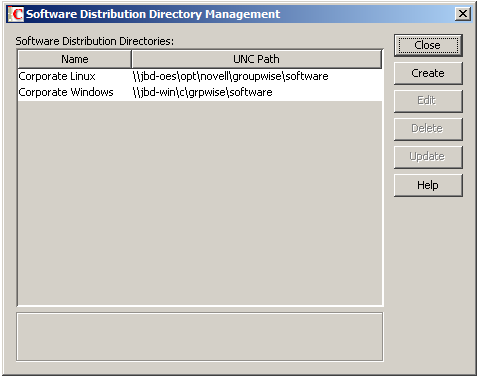
-
Select the software distribution directory for the post offices where you want to update the Windows client software, then click .
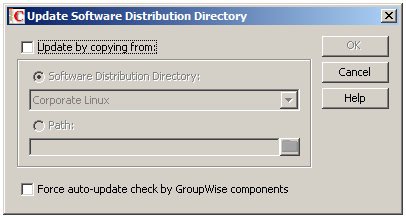
-
(Conditional) If the Windows client software is being installed from a mapped drive, select , then select or browse to and select another location.
If the Windows client software is being installed from a Web server, the updated software has already been made available, as described in Preparing for Windows Client Installation from a Web Server.
-
Select , then click .
-
Continue with Section 77.1.4, Understanding the User’s AutoUpdate Experience.
77.1.4 Understanding the User’s AutoUpdate Experience
The next time each client user starts the Windows client, the client detects that the software version in the software distribution directory has been updated. It launches the Windows client Setup program (setup.exe), which runs according to the settings you have provided in the setup.cfg file.
If you are forcing the user to update (ForceUpdate=Yes in the setup.cfg file), the following message appears:
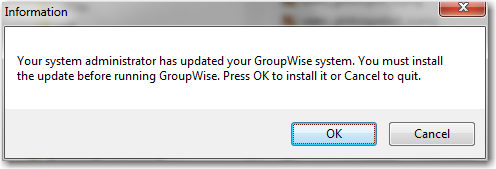
If you are not forcing the user to update (ForceUpdate=No in the setup.cfg file), the following message appears:
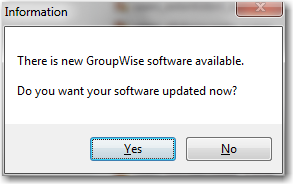
If a mapped drive to the software distribution directory is found, the Windows client software is installed from the mapped drive by the client Setup program (setup.exe).
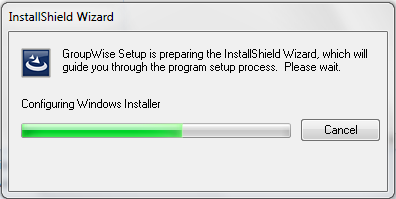
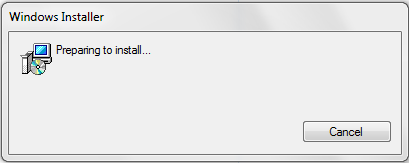
If a mapped drive to the software distribution directory is not found and you have enabled SetupIP (SetupIPEnabled=Yes in the setup.cfg file), the user sees the software being downloaded from the Web server:
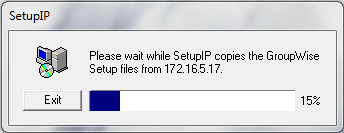
The installation then proceeds based on your choices in the [ShowSetup] section of the setup.cfg file.
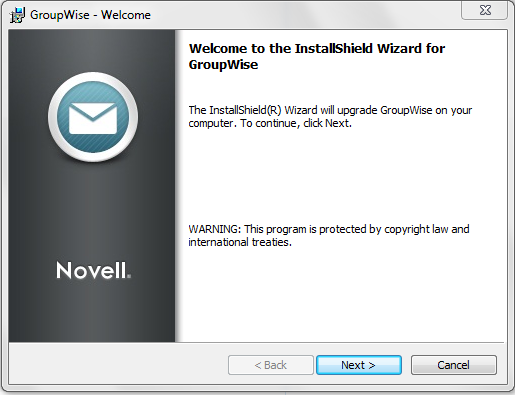
If you turned off all dialog boxes, users do not see the Setup program running.
77.1.5 Using the AutoUpdate Error Log Files
If no connection to a software distribution directory can be made, the setupip.err file is created in c:\windows on the user’s workstation. This file explains why none of the connections could be made.
If an error occurs during the software update and ShowDialogs is set to No in the setup.cfg file, the error message is logged in the gwsetup.err file in the user’s c:\windows directory.
If you add ErrorMessage=error_text as the last entry under the [GroupWiseSetup] section in the setup.cfg file, the specified error text is displayed. Otherwise, a generic error message is displayed, notifying the user to contact the system administrator.
77.1.6 Disabling Your AutoUpdate Customizations
To stop the Windows client Setup program (setup.exe) from using the setup configuration file (setup.cfg), delete setup.cfg from the client/win32 directory where setup.exe resides. Without a setup.cfg file, the Setup program offers the user all client installation options to choose from.